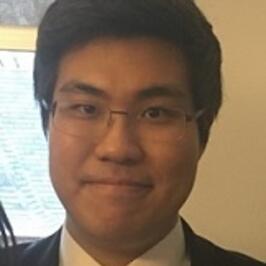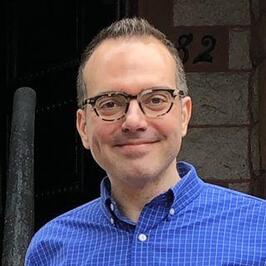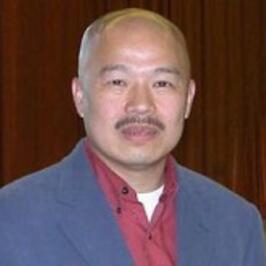Events Archive
ICQMB Seminars, Fall 2020
2:00-3:20pm Tuesday, Sep.29th – Dec. 8th, Fall 2020
For zoom meeting information of the seminars, please contact Dr. Qixuan Wang
Tuesday, October 6th, 2020
2:00 - 3:20 p.m.
Title: Understanding high feedback and hidden feedback in gene regulatory networks through mathematical modeling
Dr. Tian Hong, University of Tennessee, Knoxville
Abstract: Multistep cell fate transition is a common form of phenotypic plasticity observed in many biological systems. It was not known what types of transcriptional networks can give rise to the stepwise feature. With unbiased searching in the network topology space, we discovered a large family of network motifs consisting of interconnected feedback loops that have the capability to generate a four-attractor system. We found that these motifs are enriched in a transcriptional network controlling the early T cell development, and by constructing models based on our generic framework, we elucidated previously unclear mechanisms underlying the multistage and irreversible process in which the stemness of the lymphoid progenitor cells is lost. More recently, we found that simple post-transcriptional reaction networks involving microRNA can generate multistability, a feature that is typically achieved through transcriptional feedback loops in development. Through mathematical modeling, we revealed a hidden feedback mechanism between microRNA and mRNA. With an experimental system involving motor neuron development in the spinal cord, we showed that this hitherto unknown mechanism may be responsible for robust lineage segregation at a tissue boundary.
Tuesday, October 13th, 2020
2:00 - 3:20 p.m.
Title: Active Fluids: Topological Defects, Turbulence, and Phase Separation
Dr. Ricard Alert Zenon, Princeton University
Abstract: Active fluids display striking collective phenomena not possible in passive fluids. Examples include spontaneous flows powered by microscopic constituents, and phase separation in the absence of attractive interactions. In this talk, I will discuss three aspects of the physics of active fluids, connected with experiments in both biological and artificial soft matter systems. First, I will show that dense colonies of the rod-shaped motile bacterium Myxococcus xanthus form active liquid crystals. I will show that topological defects of the cell alignment field induce flows that lead to the formation of new cell layers, which triggers the development of multicellular structures called fruiting bodies. Second, I will discuss chaotic flows in active liquid crystals. I will show that, as in classic turbulence, the statistical properties of these active flows at low Reynolds number are described by universal scaling laws. Unlike classic turbulence, however, this type of active turbulence requires no energy transfer across scales. Finally, I will present a new mechanism of liquid-gas phase separation in active fluids. I will show that, in addition to repulsive forces that oppose phase separation, artificial self-propelled Janus colloids experience torques that reorient particle motion toward high-density regions, providing a novel route to phase separation.
Tuesday, October 20th, 2020
2:00 - 3:20 p.m.
Title: Divergent trajectories of single-cell aging
Abstract: Cellular aging is a complex process that involves many interwoven molecular processes. Studies in model organisms have identified many individual genes and factors that have profound effects on lifespan. However, how these genes and factors interact and function collectively to drive the aging process remains unclear. We investigated single-cell aging dynamics throughout the replicative lifespans of S. cerevisiae, and found that isogenic cells diverge towards two aging paths, with distinct phenotypic changes and death forms. We further identified specific molecular pathways driving each aging fate and revealed that these pathways interact and operate dynamically to enable an early-life switch that governs the aging fate decision and the progression towards death. Our work uncovers the interconnected molecular pathways that drives the aging process and opens up the possibility of designing interventions that simultaneously target multiple network nodes, instead of single genes, to more effectively extend the healthspan.
Tuesday, October 27th, 2020
2:00 - 3:20 p.m.
Title: TBA
Dr. Hui Sun, UCU Long Beach
Abstract: TBP
"Turing Patterns on Turing Machines"
https://www.lorentzcenter.nl/turing-patterns-on-turing-machines.html
**11am PST Thursday, August 27th, by James Sharpe, Head of the EMBL, Barcelona: https://www.embl.es/
To attend the lecture, please register online.
**Due to global technical issues in the Kultura video conference platform the public lecture ‘Turing Patterns on Turing Machines’ by James Sharpe will be rescheduled to tomorrow, Thursday 27th of August 2020. The programme and technical instruction will be the same. We apologize for the inconvenience and hope you can join us tomorrow.
Founded in 1974, EMBL is Europe’s flagship laboratory for the life sciences– an intergovernmental organization with more than 80 independent research groups covering the spectrum of molecular biology. It operates across six sites: Heidelberg, Barcelona, Hamburg, Grenoble, Rome and EMBL-EBI Hinxton.
The Sharpe group brings together an interdisciplinary team of biologists,physicists and computer scientists to build multi-scale computer simulations of a paradigm of organogenesis – mammalian limb development: https://www.embl.es/research/unit/sharpe/
The public lecture is part of the Lorentz Center Workshop on Modeling Shape and Size in Biological Development that is run online from 24th-28th August 2020: https://www.lorentzcenter.nl/site/index.php?pntHandler=WorkshopTemplatePage&pntType=ConPagina&id=301
It is co-sponsored by the UCR Interdisciplinary Center for Quantitative Modeling in Biology
Thursday, July 23rd, 2020
11:00 a.m. - 12:00 noon
Online Zoom Seminar - Email Qixuan Wang to request the link.
Title: Challenges and Opportunities in CAR T-Cell Therapy for Cancer: From experiment, to data, to clinical applications of mathematical models, and beyond
Dr. Russell Rockne, Department of Computational and Quantitative Medicine, Beckman Research Institute, City of Hope
Abstract: Chimeric antigen receptor (CAR) T-cells are an exciting and challenging therapy for cancer in which T-cells are extracted from the patient, engineered to recognize cancer cells, and injected back into the patient. Because CAR T-cells are a "living" therapy, with their own dynamical properties, such as proliferation, migration, exhaustion, and potential for interaction with non-cancerous cells in the body, CAR T-cell therapy is an intriguing nonlinear dynamical system. In this talk, I will show how we integrate mathematical modeling with in vitro and in vivo preclinical studies to optimize the dose, timing, and sequence of CAR T-cell therapies for a range of clinical settings, including combination therapies. The emphasis of this informal talk will be on opportunities for collaborations between investigators at City of Hope and UC Riverside.
Bio: Dr. Rockne is Assistant Professor and Director of the Division of Mathematical Oncology in the Department of Computational and Quantitative Medicine at City of Hope. Dr. Rockne’s research lies at the interface of precision medicine, data science, and mathematical modeling. Dr. Rockne’s research approach uses mathematical models to connect data from multiple modalities and scales to predict cancer growth and response to therapy. Dr. Rockne has made contributions to mathematical model parameterization and applications, with patented algorithms as well as first and senior author level peer reviewed publications in the field of Mathematical Oncology. Dr. Rockne partners with scientists and clinicians at City of Hope to bring mathematics into the clinic to help improve outcomes for patients with cancer.
Wednesday, June 3rd, 2020
1:00 - 2:00 p.m.
Online Zoom Seminar - Email Qixuan Wang to request the link.
Title: Understanding Complex Systems from Heterogeneous Data via Machine Learning
Dr. Seungjoon Lee, Department of Chemical and Biomolecular Engineering, Johns Hopkins University
Abstract: In the age of big data, recent developments in efficient measurement/simulation capabilities enable us to collect extensive data sets from heterogeneous sources across the different levels of fidelity, accuracy, scale, and resolution. Yet, understanding the spatiotemporal dynamic behavior of the complex system directly from data has been lagging behind due to the requirement of prior knowledge/intuition about the system. Modern data-driven approaches via machine learning suggest alternative ways to understand the underlying system directly from heterogeneous data. In this talk, I present such data-driven frameworks (1) to effectively combine heterogeneous data (e.g. multi-fidelity data); (2) to extract salient coarse-scale variables from fine-scale data; (3) to identify the corresponding coarse-scale governing equations (e.g. Partial Differential Equations or PDEs); (4) to control the complex system at the coarse-level under the uncertainties. Specifically, I employ machine learning (here Gaussian Processes) with/without data-driven embedding to combine multi-fidelity data. After that, I extract salient coarse-scale observables (e.g. concentration) from fine-scale data and discover the underlying coarse-scale PDEs using manifold learning (Diffusion Maps) and machine learning (Gaussian Processes and Artificial Neural Networks). I will demonstrate the effectiveness of the proposed data-driven frameworks through various examples in fluid dynamics, computational biology, dynamical system, and control. Moreover, I will present future work about the optimal design and control of the complex system under the uncertainties using the coarse-scale data-driven framework.
Bio: Dr. Seungjoon (Joon) Lee is currently a Postdoctoral Fellow in the Department of Chemical and Biomolecular Engineering/Applied Mathematics and Statistics, Johns Hopkins University. He received a master’s degree in Mechanical Engineering from Carnegie Mellon University and a Ph.D. degree in Applied Mathematics from Brown University. His research focuses on scientific machine learning. Specifically, (1) analyzing heterogeneous data, (2) making an implicit/explicit model that effectively describes the underlying complex system, and (3) control a complex system with minimal controllers under uncertainties.
Tuesday, June 2nd, 2020
11:00 a.m. - 12:20 p.m.
Online Zoom Seminar - Email Qixuan Wang to request the link.
Title: Ligand Expression and Lung Development: A Mathematical Perspective
Dr. Uduak Z. George, Department of Mathematics and Statistics,Computational Science Research Center, Viral Information Institute, San Diego State University
Abstract: Lung development is a highly stereotyped process that is regulated by myriad of factors including ligand-ligand interactions. Ligands such as fibroblast growth factor 10 (FGF10) and sonic hedgehog (SHH) are critical regulators of lung development. Mice that do not express FGF10 exhibit severe lung abnormalities. Understanding the temporal and spatial regulation of FGF10 expression is challenging because of the complex nature of lung development. Mathematical modeling provides a powerful approach for unraveling the dynamics of FGF10 expression. In this talk, I will show how we applied a coupled system of surface reaction-diffusion equations to study the interactions between FGF10 and SHH. I will present new findings from the model simulations that identifies tissue growth and SHH interactions as sufficient conditions for FGF10 patterning during lung development.
Bio: Dr. Uduak George is an Assistant Professor at San Diego State University. She obtained a PhD in Mathematics from the University of Sussex in England. She is a mathematical biologist. Her research focuses on applying mathematical modeling to understand the mechanisms underlying biological processes such as lung development and lung functioning in diseases such as cystic fibrosis and primary ciliary dyskinesia.
Tuesday, May 26th, 2020
11:00 a.m. - 12:20 p.m.
Online Zoom Seminar - Email Qixuan Wang to request the link.
Title: Bayesian uncertainty quantification for particle-based simulations
Dr. Anastasios Matzavinos, Division of Applied Mathematics, Brown University
Abstract: A number of problems of interest in applied mathematics and biology involve the quantification of uncertainty in computational and real-world models. A recent approach to Bayesian uncertainty quantification using transitional Markov chain Monte Carlo (TMCMC) is extremely parallelizable and has opened the door to a variety of applications which were previously too computationally intensive to be practical. In this talk, we first explore the machinery required to understand and implement Bayesian uncertainty quantification using TMCMC. We then describe dissipative particle dynamics, a computational particle simulation method which is suitable for modeling biological structures on the subcellular level, and develop an example simulation of a lipid membrane in fluid. Finally, we apply the algorithm to a basic model of uncertainty in our lipid simulation, effectively recovering a target set of parameters (along with distributions corresponding to the uncertainty) and demonstrating the practicality of Bayesian uncertainty quantification for complex particle simulations.
Bio: Anastasios Matzavinos is a faculty member of the Division of Applied Mathematics at Brown University. His research interests revolve around applied mathematics and computational biology with a special emphasis on data-driven modeling and Bayesian approaches to model selection. He is the recipient of several grants and awards, including an NSF CAREER award.
UCR Interdisciplinary Center for Quantitative Modeling in Biology Colloquium
Friday, May 15th, 2020
12:00 - 1:00 p.m.
Online Zoom Seminar - Email Qixuan Wang to request the link.
Title: Linking structure to biomechanical behaviors of plant primary cell walls
Daniel J. Cosgrove, Tian Zhang, Yao Zhang and Sulin Zhang, Department of Biology and Center for Lignocellulose Structure and Formation, Pennsylvania State University
Abstract: How the molecular organization of the plant primary cell wall accommodates its dual needs for mechanical strength and high extensibility (surface expansion) is a subject of long-term and widespread interest and debate, as it is one of the foundations for plant growth, morphogenesis and biomechanics. To explore how wall structure gives rise wall mechanical behaviors, we studied cell-free strips of onion epidermal walls by several complementary methods. This system avoids problems inherent with use of living tissues, where geometry and biological responses can complicate the interpretation of many experiments. Atomic force microscopy (AFM) revealed the organization of cellulose microfibrils in this cross-lamellate wall and showed complex patterns of microfibril movements with different types of strain. Several different mechanical assays were combined with enzyme digestions to assess which polysaccharides bear mechanical forces in-plane and out-of-plane of the cell wall. This approach provides critical tests of current hypotheses of wall structure, material properties, tissue mechanics, and mechanisms of cell growth. We conclude that these various mechanical properties are not tightly coupled with each other and thus reflect distinctive aspects of wall structure. The cross-lamellate network of cellulose microfibrils dominated the behavior of the wall in tensile creep and stiffness assays, whereas pectin influenced indentation mechanics. Enzymatic digestion of xyloglucan did not alter wall mechanics in any of the assays, contrary to the common view that xyloglucan tethers microfibrils together. This information is being used to construct a coarse-grained model of the cell wall for insights into nanoscale interactions and movements underlying cell wall mechanics.
For more information, see:
Zhang, T., Tang, H., Vavylonis, D. and Cosgrove, D.J. (2019) Disentangling loosening from softening: insights into primary cell wall structure. Plant Journal, 100, 1101-1117.
Cosgrove, D.J. (2018) Diffuse growth of plant cell walls. Plant Physiology, 176, 16-27.
Zhang, T., Vavylonis, D., Durachko, D.M. and Cosgrove, D.J. (2017) Nanoscale movements of cellulose microfibrils in primary cell walls. Nature Plants, 3, 17056.
Zhang, T., Zheng, Y. and Cosgrove, D.J. (2016) Spatial organization of cellulose microfibrils and matrix polysaccharides in primary plant cell walls as imaged by multichannel atomic force microscopy. Plant Journal, 85, 179-192.
Wednesday, May 6th, 2020
1:00 - 2:00 p.m.
Online Zoom Seminar - Email Qixuan Wang to request the link.
Title: On the Origin of Mammalian Early Embryo Symmetry-Breaking
Dr. Qi Chen, Division of Biomedical Sciences, School of Medicine, University of California, Riverside
Abstract: In mammalian preimplantation embryo development, when the first asymmetry emerges and how it develops to direct distinct cell fates are two longstanding questions. It remains debatable whether the first bifurcation of cell fate emerges randomly at morula stage, or has been predetermined at earlier stages before morphological distinction. Combining single-cell RNA-seq analysis and mathematical modeling, we recently showed that the very first symmetry-breaking process involves both chance separation and defined transcriptional circuits. From our single-embryo transcriptome analysis, small biases at molecular level will inevitably emerge at the 2-cell embryo stage, following a binomial distribution due to the cleavage division. At this stage, the blastomere-to-blastomere distribution seems random but during subsequent zygotic transcriptional activation, a “bistable pattern” emerges in some genes. Several lineage specifiers show a strong bias between different blastomeres thus providing potential for further increased asymmetry subsequently. These observations suggest a scenario of how order is created from a seemingly random process through the differential triggering of existing master regulators by the emergence of their small bias. Recently, we also proposed that compartmentalized intracellular reactions, such as those mediated by cell-cell contact and cell geometry, generate micro-scale inhomogeneity, which is amplified in the developing embryo, driving pattern formation. Ongoing research in my lab strive to address these hypotheses.
Bio: Current research in Qi Chen lab focus on two areas:
1) Epigenetic inheritance mediated by sperm RNAs and RNA modifications. Researches from Qi Chen lab and others revolutionized our idea about the hereditary information carried by sperm, by demonstrating that paternally acquired traits from environmental stressors can be “encoded” in the form of sperm RNAs and RNA modifications, which transmit paternal phenotypes to the offspring beyond DNA sequence.
2) Tracing the origin of heterogeneity and symmetry breaking in the early mammalian embryo. In mammalian preimplantation embryo development, when the first asymmetry emerges and how it develops to direct distinct cell fates are two longstanding questions. We developed a keen interest on the origin (molecular and cellular) of early mammalian embryo symmetry-breaking before blastocyst formation, for which we are now utilizing the power of single-cell technology and mathematical modeling to study with.
For more information check our lab website: http://qichen-lab.info/
Tuesday, May 5th, 2020
11:00 a.m. - 12:20 p.m.
Online Zoom Seminar - Email Qixuan Wang to request the link.
Title: Quantitative personalized oncology - calculus in clinical decision making
Dr. Heiko Enderling, Moffitt Cancer Center & Research Institute
Abstract: In quantitative personalized oncology we develop clinically motivated calibrated quantitative models that are informable with patient-specific data for personalized treatment recommendations. In close collaboration with experimentalists and clinicians, mathematical models that are parameterized with experimental and clinical data can help estimate patient-specific disease dynamics and treatment success. This positions us at the forefront of the advent of ‘virtual trials’ that predict personalized optimized treatment protocols. Here, we will discuss a couple of different models to demonstrate how to integrate calculus into clinical decision making. First, we show that a mathematical model can be calibrated from early treatment response dynamics in patients undergoing hormone therapy for prostate cancer. The learned model dynamics can then be used to forecast responses to subsequent treatment, and identify high risk patients who would benefit form concurrent therapies. In a second example, we will discuss pre-treatment and during treatment dynamics for patients undergoing radiotherapy for head and neck cancer. We show that routinely collected data can inform a mathematical model to accurately predict responses, thus allowing to adapt therapy when necessary.
Bio: I am a tenure-track Associate Member in the Integrated Mathematical Oncology Department, with a secondary appointment in Radiation Oncology at Moffitt Cancer Center & Research Institute. As a trained computer scientist and mathematician my research is focused on developing and applying quantitative modeling techniques to simulate tumor growth and predict treatment response. My interdisciplinary career began with an undergraduate degree in Computer Science applied to human medicine at the University of Magdeburg, Germany, followed by graduate studies in Mathematical Biology at the University of Dundee, Scotland. After a postdoctoral fellowship I advanced to the rank of Assistant Professor at the Center of Cancer Systems Biology at Tufts University School of Medicine, before moving to Moffitt Cancer Center in 2013.
April 28th, 2020
11:00 a.m. - 12:20 p.m.
Online Zoom Seminar - Email Qixuan Wang to request the link.
Title: Modeling the Dynamics of Centrosome Movement
Dr. Sarah Olson, Department of Mathematical Sciences, Worcester Polytechnic Institute
Abstract: The mitotic spindle is a complex, dynamic machine important for cell division. The spindle is composed of a network of microtubules and motor proteins that generate forces to form a bipolar spindle, with each pole organized around a single centrosome. Disruption in force generating activities through protein depletions or alterations to centrosome number, alter spindle structure and affect the fate of the cell in mitosis. Centrosome amplification leads to multipolar spindle formation and multipolar division, which results in daughter cells with decreased viability. However, cancer cells actively cluster extra centrosomes to form a functional bipolar spindle. We highlight initial modeling and experimental efforts to understand the dominant forces that lead to the formation of either a multipolar or functional bipolar spindle in the case of extra centrosomes. Time permitting, we will also highlight other recent projects related to cancer cell dynamics and cumulative cellular absorption of drugs.
Bio: Dr. Sarah Olson is an Associate Professor in the Department of Mathematical Sciences at Worcester Polytechnic Institute and affiliated with Biomedical Engineering and the Bioinformatics and Computational Biology Program. Olson received her undergraduate degrees in Mathematics and Biology from Providence College, a master's from the University of Rhode Island in Mathematics, and a PhD in Biomathematics from North Carolina State University. She completed her postdoc at Tulane University and has worked in the general areas of fluid dynamics, scientific computing, and mathematical biology.
April 21st, 2020
11:00 a.m. - 12:20 p.m.
Online Zoom Seminar - Email Qixuan Wang to request the link.
Title: Pattern Transitions in Spatial Epidemiology: Implications for coping with the emerging epidemics (e.g. the ongoing COVID-19 pandemic)
Dr. Larry Li, Professor of Ecology, Department of Botany and Plant Sciences, UC Riverside
Abstract: The explanation and prediction of spatial patterns of infectious disease, particularly those of emerging pathogens like SARS-CoV-2, have remained a central problem of epidemiology since its inception, for example, theoretical models combined empirical data to study rabies and the Black Death. In this talk, I will start with the introduction of ecological spatiotemporal patterns and pattern formations via PDE and CA-SIRS models with von Neumann and Moore configurations; then I will focus on our previous and current works on the emergence and types of pattern transitions including patch invasions, the mechanisms driving pattern transitions (such as spatial heterogeneity, seasonality, noise, and human behavior), and the epidemiological role of pattern transitions. Such pattern transitions can be served as early warnings for the outbreak of diseases. Coherence resonance and cyclic evolution of host-pathogen system pattern transitions could also provide further understanding of the emerging epidemics such as the ongoing coronavirus pandemic.
Bio: Larry Li is Professor of Ecology with a broad interdisciplinary background and experience in mathematical, statistical and computational modeling applications in biological, ecological and environmental studies. He published more than 250 refereed journal articles, 30 book chapters and proceedings papers, and 11 books or edited special issues. Among his many honors and awards, he was elected to be Honorary Member of the Scientific Council of Russian Academy of Sciences (2005), IHE Fellow (1988), AAAS Fellow (2006), DeTao Master of Ecology (2013), and received 2015 Prigogine Gold Medal (only one leading scientist per year to be awarded in ecological systems internationally). He is also Founding Editor-in-Chief of two international journals: Ecological Complexity (Elsevier; 2004) and Journal of Arid Land (Springer Nature; 2009).
April 7th, 2020
Online Zoom Seminar - Email Qixuan Wang to request the link
Title: Combining Data, Control Theory, Statistical Thermodynamics with Machine Learning to Predict Enzyme Regulation, Metabolite Concentrations and Rate Constants
William R. Cannon1,2, Samuel Britton2, Mark Alber2
1 Biological Sciences Division, Pacific Northwest National Laboratory, Richland, WA, 99352; 2 Department of Mathematics, University of California, Riverside, Riverside, CA 92521
Abstract: Experimental measurement or computational inference/prediction of the enzyme regulation needed in a metabolic pathway is hard problem. Consequently, regulation is known only for well-studied reactions of central metabolism in a few organisms. In this study, we use statistical thermodynamics and metabolic control theory as a theoretical framework to determine the enzyme activities that are needed to control metabolite concentrations such that they are consistent with experimentally measured values. A reinforcement learning approach is utilized to learn optimal regulation policies that match physiological levels of metabolites while maximizing the entropy production rate and minimizing the heat loss. The learning takes a minimal amount of time, and efficient regulation schemes were learned that agree surprisingly well with known regulation. The learning is facilitated by a new approach in which steady state solutions are obtained by convex optimization rather than ODE solvers, making the time to solution seconds rather than days. The optimization is based on the Marcelin-De Donder formulation of mass action kinetics, from which rate constants are inferred. Consequently, a full ODE-based, mass action simulation with rate parameters and post-translational regulation is obtained. We demonstrate the process on three pathways in the central metabolism E. coli (gluconeogenesis, glycolysis-TCA, Pentose Phosphate-TCA) that each require different regulation schemes.
Bio: Dr. Cannon is a senior scientist at the Pacific Northwest National Laboratory in Richland, WA. He led the Computational Biology Group at PNNL before recently taking an adjunct position at UC Riverside. His training is in statistical thermodynamics, biochemistry, biophysics and enzymology.
Research Areas: Computational physics, biochemistry and proteomics; Modeling and simulation including deterministic and stochastic simulation of metabolism; stochastic methods, microbial metabolism; statistics, statistical mechanics and statistical proteomics data analysis.







